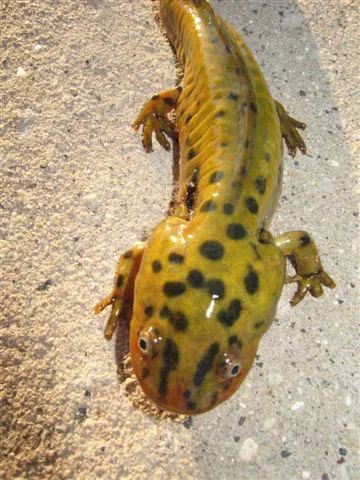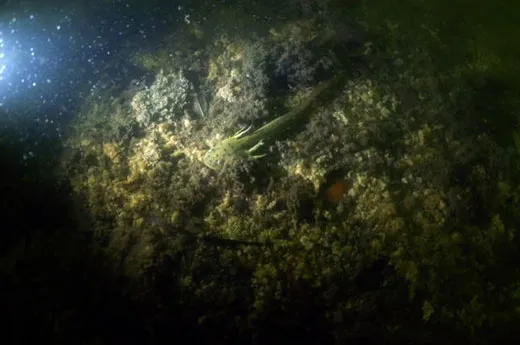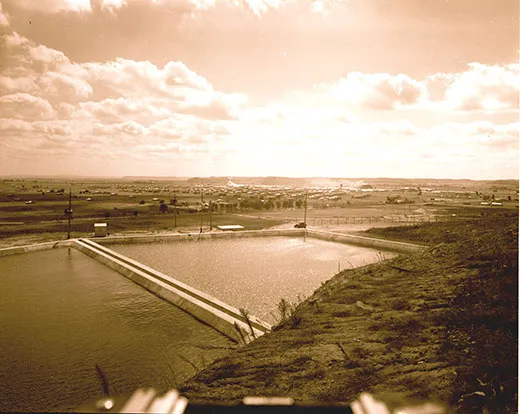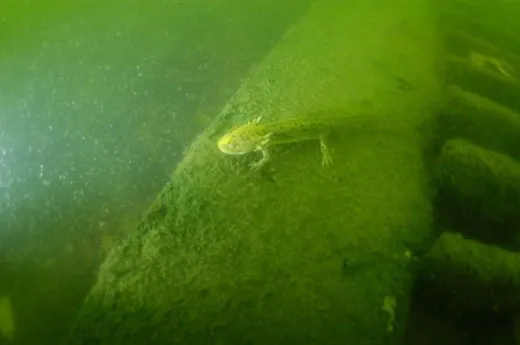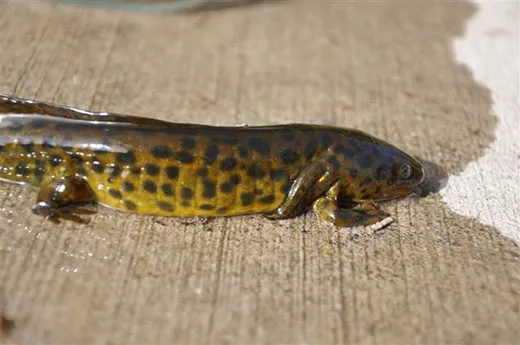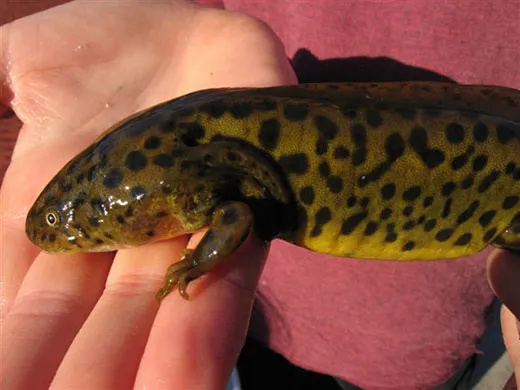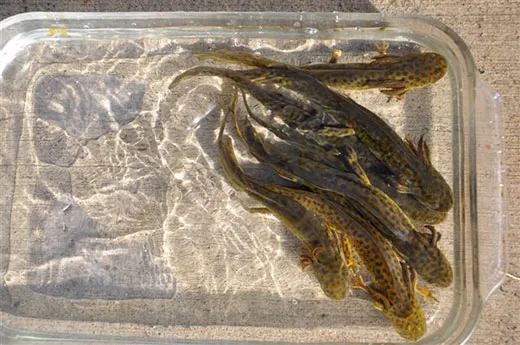The Salamanders that Refuse to Grow Up
In a Wisconsin reservoir, these normally terrestrial animals have managed not only to survive but to thrive underwater
/https://tf-cmsv2-smithsonianmag-media.s3.amazonaws.com/filer/salamanders-underwater-631.jpg)
Dead leaves drift on the green, cloudy water that’s nearly to the brim of the six-million-gallon open concrete reservoir. Set on a tree-covered hillside, the reservoir is surrounded by a metal fence, like a community swimming pool long forgotten. It lies on the northern edge of the decommissioned Badger Army Ammunition Plant, a sprawling World War II-era ammunition factory 30 miles northwest of Madison, Wisconsin. Once one of the largest ammunition plants in the world, Badger is polluted by metals, solvents and explosives waste and is now being dismantled, piece by contaminated piece.
Workers strip away siding from nearby buildings and remove bricks. Bulldozers push mounds of dirt and broken concrete blocks, while trucks mounded high with bent metal rods, window frames and other debris create a rush hour of demolition on the heavily secured grounds. The landscape is slowly becoming more open and green, the prairie reappearing from beneath the plant.
The reservoir is unremarkable from the surface. But underwater, it’s home to a surprising animal that has managed to survive in this inhospitable and unlikely habitat. Salamanders cling to the sides, bottom and drain gate of the reservoir and swim through the water. They aren’t just any salamanders. They are adult Eastern Tiger Salamanders—some of the world’s largest salamanders—and they are supposed to live on land. But these salamanders are swimming and living a fully aquatic life with feathery gills, wide jaws, and tail fins.
“We don’t know how long they’ve been in there, but probably a few decades,” says Mike Mossman, an ecologist with the Wisconsin Department of Natural Resources. “We think there’s more than a thousand of them now.”
Mossman is at the reservoir collecting eggs and hopefully a salamander or two for further study. The long rope attached to a buoy and several thermometers in the middle of the reservoir turns out to hold dozens of eggs, black dots stuck to the rope fibers in gelatinous, clear egg sacs. Mossman scrapes them into a plastic bottle, elated at his find and hopeful for what they may allow scientists to learn about these strange salamanders.
Herpetologist Gary Casper of the University of Milwaukee discovered the salamanders while doing a survey of the reservoir for the Army in 1993. “I didn’t know what I had found at first,” says Casper. “We had no idea how uncommon these larval characteristics, like gills, were in the Eastern tiger salamander at the time.”
Ever since, Casper and other researchers from the Army and the state Department of Natural Resources have been trying to determine how these normally terrestrial animals have managed not only to survive but to thrive underwater.
But now time is running out for the salamanders, and scientists are rushing to study and possibly find a new home for them before the reservoir is drained.
Amphibians, such as frogs, toads and salamanders, lay eggs in water, even though most species spend the majority of their adult lives on land. The eggs hatch and develop into larvae—tadpoles in frogs and “efts” in salamanders. But occasionally amphibian development takes an odd turn. Sometimes larvae mature to a reproductive stage without undergoing the normal process of metamorphosis for a land-based adult life. This condition is called “neoteny.” They never lose their gills, tail fins, larval skin coloration and wide heads. They also never leave the breeding pond. This seemed to be exactly what happened to the Badger salamanders.
The open reservoir at Badger provided easy entry for the salamanders looking for a place to lay eggs, but a seven-inch-wide lip prevented them from getting out. Stuck in the reservoir, the breeding salamanders laid eggs and likely died. When their eggs hatched, any of the offspring that metamorphosed into the usual, land-dwelling form also died, unable to swim for long in the deep water. But somehow, others managed to survive by becoming neotenic.
“Like tadpoles with legs” is how Mossman describes the Badger salamanders. The adults have the same yellowish color with dark spots as the larvae as well as red feathery gills, but like regular adults, they are nearly a foot in length.
Their aquatic world has been captured on film by maritime archaeologists from the Wisconsin Historical Society. Used to diving for shipwrecks in the Great Lakes, the archaeologists have used their skills to videotape the salamanders’ underwater habitat.
“Based on what we thought we knew about Eastern tigers, we would predict that these salamanders would drown in that reservoir,” explains Michael Lannoo, a professor of anatomy and cell biology at the University of Indiana School of Medicine, who has studied tiger salamanders for more than 30 years.
The Badger salamanders aren’t the first neotenic Eastern tiger salamanders to be found. But the Badger salamanders are perhaps the first human-induced neotenic population and are the only population known to have existed for many generations and to be well established.
The fact that these salamanders became neotenic under unnatural conditions—an Army reservoir—suggests that the species must have done this in the past, says Lannoo. He thinks the key to why salamanders usually don’t exhibit neoteny today is fish. Amphibians and fish rarely live in the same places. Nearly every body of water that can support fish has fish in the modern landscape. Fish often eat amphibian eggs and larvae, so amphibians tend to stick to seasonal and semipermanent wetlands, places where fish do not usually survive. “It’s how fish and amphibians have sorted out the landscape,” explains Lannoo.
But 200 years ago, before people began introducing fish to wild areas, fish were not as widespread as they are now. Some lakes and ponds had no fish. Amphibians likely lived in all kinds of water, including permanent bodies of water like lakes. To test this hypothesis, scientists needed an isolated, fish-free body of water, a situation nearly impossible to find in nature today. That is, until salamanders were discovered in the water reservoir at the Badger Army Ammunition Plant.
The thick-walled concrete reservoir once supplied millions of gallons of water for fire control and the production of propellants for use in firearms and artillery. Constructed in 1942, the war machine at the heart of the Sauk Prairie employed more than 30,000 men and women during its 58-year history, supplying three wars. The operation was massive: more than 7,400 acres covered with 1,400 buildings, many of them made of blast-proof concrete, 130 miles of roads, 200 miles of elevated steam pipe and 26 miles of railway. In the midst of this industrial landscape, nature still crept in.
Badger’s man-made reservoir mimicked the historic landscape: a permanent body of water free of fish. And sometime after the reservoir was dug, salamanders began falling in, either accidentally or to lay eggs.
“The reservoir’s purpose was to hold water for a process that made gunpowder, a destructive process,” says Mossman. “And yet a whole living system developed behind our backs, without our knowledge and control.”
The reservoir population seems to prove that Eastern tiger salamanders are capable of surviving to adulthood in water; that they can become neotenic in the right conditions; and that they may have commonly lived in permanent bodies of water in the past. Casper, Mossman and Lannoo believe that the Badger salamanders may represent one of the last instances of a biological phenomenon that was once widespread.
“The salamanders adapted to what Badger gave them,” says Mossman. “The whole system is pretty unusual, but they’ve managed to thrive in this environment. It’s all theirs.”
The reservoir may not be theirs for long, however. It’s scheduled to be drained as early as this fall. Maintaining the reservoir requires work and money, and with the transition of the Badger property to civilian use, it just isn’t needed anymore.
The researchers are scrambling to learn as much as they can before the reservoir is gone. They also hope to find a home for the salamanders that will preserve their neotenic state. Once removed from the reservoir, the salamanders will metamorphose fairly quickly—within several weeks for most neotenic adults—so the habitat is just as important as the salamanders themselves for understanding neoteny and what happened at Badger. All of this is complicated by the many still unanswered questions about the salamanders’ biology. It’s hard to find the salamanders a home when the factors governing their neotenic status aren’t yet known.
“It really is an amazing educational opportunity,” says Mossman. “The Badger salamanders are a living testament to the persistence of life.”
Erika Janik is a writer and radio producer in Madison, Wisconsin.
